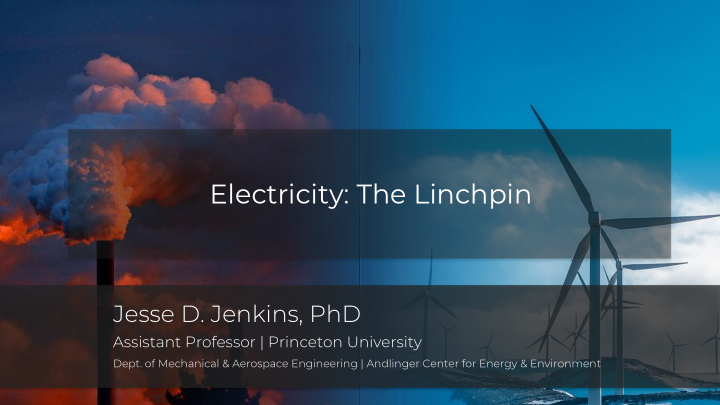



m Electricity: The Linchpin Jesse D. Jenkins, PhD Assistant Professor | Princeton University Dept. of Mechanical & Aerospace Engineering | Andlinger Center for Energy & Environment
Getting to Zero to Zero 2°C 1.5°C Window Window 2045- 2060- 2060 2080 Source: IPCC (2018) Special Report on Global Warming 1.5°C 2
Twin Challenges: Zero Carbon, (approx.) Double Demand Electricity: the Linchpin Total Electricity Generation by Fuel Natural gas Coal Oil & other fossil Existing nuclear Existing hydro Existing other renewables Total Electricity Demand by Electrification Scenario 10,000 High Mid Low +125% 8,000 +80% Terawatt-hours +50% 6,000 4,000 2,000 0 2020 2030 2040 2050 Data source: Iyer et al. 2017, GGCAM USA Analysis of U.S. Electric Power Sector Transitions (performed for the United States Mid-Century Strategy for Deep Decarbonization), Pacific Northwest National Laboratory; 2020 zero-carbon electricity supply from EIA Annual Energy Outlook 2019. For nuclear retirements: 8 GW of planned nuclear retirements through 2030, half of the fleet assumed to operate through 2050 (requiring 80 year licenses); 2040 a linear interpolation of 2030 and 2050. 3 3
New Clean Electricity Needed: Obama Mid-Century Strategy Electricity: the Linchpin (a) Total New Carbon-free Electricity Generation (b) Annual Additions Rate (2020-2050) 9,000 Electrification Scenarios +31 avg GW/yr 30 Mid High Low 8,000 +24 avg GW/yr 7,000 25 Terawatt-hours Average gigawatts per year +20 avg GW/yr 6,000 20 Total 2020 U.S. 5,000 electricity generation 15 4,000 U.S. U.S. non- nuclear 3,000 hydro 10 U.S. non- 1981- renewables hydro 1990*, 7.4 2016 (peak 2,000 renewables Total 2020 zero-CO2 generation year), 5.3 2010-2018, 5 3.4 1,000 0 0 *Growth rate scaled by population for comparison purposes 2020 2025 2030 2035 2040 2045 2050 (b) Data source: U.S. EIA for renewables growth rate. MIT Future of Nuclear in a Carbon (a) Data source: Difference between projected electricity demand in Iyer et al. 2017 and 2020 zero-carbon electricity supply from EIA Annual Energy Outlook 2019. Constrained World study for historic nuclear growth rate (rescaled by population for Assumes all 2020 renewable generation can be sustained through 2050 while half of U.S. nuclear fleet retires by 2050. Retirement & replacement of existing capacity 4 4 would increase new zero-carbon generation needed. comparison)
Other Historical Precedents (Scaled To U.S. Population) Electricity: the Linchpin 35 2020-2050 Average Scale-up Rates Obama Mid-cent. Strategy, High, 31 Sweden, Nuclear 1974-1983, 30 30 France, Nuclear Average GW additions per year 1979-1988, 26 Obama Mid-cent. Strategy, Mid, 24 U.S., Natural Gas 25 2001-2010, 23 Obama Mid-cent. Strategy, Low, 20 20 Germany, Non- 15 hydro Renewables, 2017 (peak year), 12 Germany, Non- 10 hydro Renewables, 2009-2018, 6 5 0 Data sources: U.S. renewables from Historical per capita deployment rates from MIT 2018, The Future of Nuclear in a Carbon Constrained World, scaled to based on projected 2035 U.S. population of 364 million from U.S. Census Bureau. 5
The Good News: Wind, Solar, Battery Costs Plummet $400 $1,000 Levelized cost of wind and solar ($/MWh) Total cost declines Lithium-ion battery pack costs ($/KWh) $350 (2009-2018) $800 $300 So Sola lar $/ $/MWh -88% 88% $250 $600 $200 $400 $150 Li-io Li ion packs $/ $/KWh -85 85% $100 $200 $50 Wind $/MWh Wi Wh -69% 69% $0 $0 2009 2010 2011 2012 2013 2014 2015 2016 2017 2018 Data Sources: Wind & solar costs from Lazard (2018), Lazard’s Levelized Cost of Energy Analysis – Version 12.0, https://www.lazard.com/media/450784/lazards- levelized-cost-of-energy-version-120-vfinal.pdf/. Battery pack costs from Bloomberg New Energy Finance (2018), Battery Price Survey, https://about.bnef.com/blog/behind-scenes-take-lithium-ion-battery-prices/ 6
7
“Fuel “Fast saving” burst” variable balancing renewables resources Long-duration “Firm” low- carbon resources “Flexible base” “Firm cyclers” 8
Make Clean Energy Cheap: Scalable Solutions for the World Image: IEA 9
Jesse D. Jenkins Assistant Professor Department of Mechanical & Aerospace Engineering and Andlinger Center for Energy & Environment Princeton University jessejenkins@princeton.edu Twitter: @JesseJenkins Linkedin.com/in/jessedjenkins Google scholar: http://bit.ly/ScholarJenkins
Recommend
More recommend